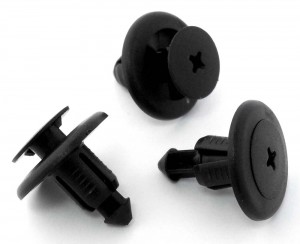 Conventional rivets are typically used to secure wooden or metal materials together, although they are also used in a variety of applications ranging from clothes and bags to plastics and even sculpture and other types of artworks. Metal rivets look like two-headed nails.
Conventional rivets are typically used to secure wooden or metal materials together, although they are also used in a variety of applications ranging from clothes and bags to plastics and even sculpture and other types of artworks. Metal rivets look like two-headed nails.
Rivets are often used as an alternative to welding, especially when fastening materials made out of metal, and are installed in a variety of ways, depending on the material that is to be fastened.
Plastic rivets, like their conventional counterparts, are also used in a variety of applications including electronics, computers, furniture, toys and vehicles. The chief advantage of using these rivets is that they can hold materials together securely, making it difficult to separate these.
If it is your first time to use a plastic rivet, here are a few helpful tips and guidelines to ensure success. Apart from the rivets, you will also need a rivet gun. When buying a rivet gun, make sure that the one you buy will not damage the surrounding paint around the materials you are trying to fasten.
Before buying rivets, it is worthwhile to count the number of holes that you will bore on the material you are working on. This will give you a fair idea of how many rivets you will need to purchase.
Once you have determined the correct number of holes and after you have purchased rivets and a rivet gun, the next thing to do is to check your rivet gun and make sure that it is working properly. The way to do it is to put the skinny end of the rivet into the rivet gun. Remember, the end that is threaded is the one that should enter the hole first.
Next, place the rivet into the hole while holding the other end into the rivet gun. From there, push the rivet gun until it is in direct contact with the surface of the material you are trying to fasten. Before shooting the rivet gun, turn it counterclockwise and then pull the rivet gun’s handle slowly.
After this, release the handle of the rivet gun and press again. Next, press the handle of the rivet gun and pull it way. Repeat this process until you have fully secured the materials you are fastening and all the holes have been covered. Finally, inspect your work and make sure that the materials are fastened securely and no rivet is sticking out.
